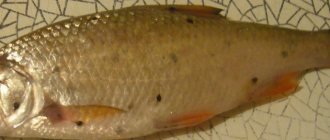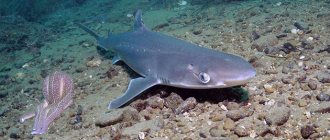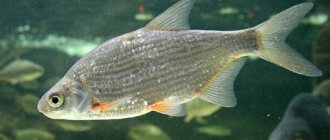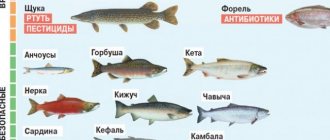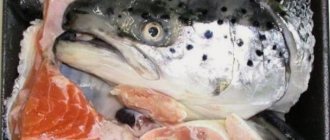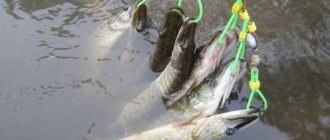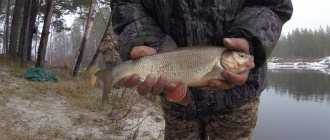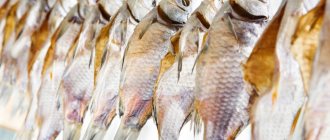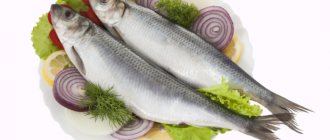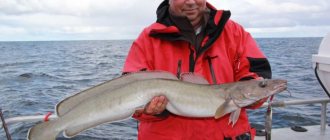What it is
Before answering the question: “Does pike suffer from opisthorchiasis?”, it is necessary to understand the mechanism of development of this dangerous helminthic infestation.
Opisthorchiasis is a severe parasitic disease that affects the liver, gallbladder and pancreas. Its causative agent is the cat fluke (liver fluke). This is a helminth belonging to the class of flatworms. The body of the worm has special suction cups, with the help of which it attaches to the internal organs of the host.
Opisthorchiasis affects not only fish and humans, but also mammals. Stray cats and dogs living near bodies of water can be infected with the liver fluke, and the insidiousness of this pathology lies in the fact that in humans the infestation can occur for a very long time without obvious manifestations. Symptoms of opisthorchiasis appear at a late stage of the disease, when severe dysfunction of the internal organs occurs.
Opisthorchiasis
The cat fluke is a small worm. The maximum length does not exceed 18 mm. The harm caused by this parasite to the human body involves not only mechanical, but also toxic effects on internal organs.
If left untreated, helminthic infestation can cause the following consequences:
- cardiac dysfunction;
- disruption of the gastrointestinal tract;
- frequently occurring ailments of the respiratory system (pneumonia, bronchitis);
- risk of developing cancer (liver cancer, pancreas cancer;
- nervous disorders.
Life cycle
To figure out whether opisthorchiasis occurs in pike, you need to know how the cat fluke reproduces and develops. This worm goes through a rather complex life cycle, during which the helminth changes its hosts:
- Infected mammals and humans shed parasite eggs in their feces.
- The eggs then end up in bodies of water. They penetrate the body of the mollusk and turn into larvae (cercariae). This stage of helminth development does not pose a danger to humans.
- Many species of fish feed on shellfish and become infected with opisthorchiasis. In their body, the larva turns into a metacercaria. It is at this stage that the helminth becomes dangerous to humans.
- People become infected by eating fish with opisthorchiasis. In the human body, the larva becomes an adult sexually mature worm and begins to parasitize the internal organs. Sick people pass eggs in their stool. After this, the life cycle of the helminth repeats again.
Opisthorchiasis can be asymptomatic for many years. Then the person experiences itchy skin, weakness, intestinal disorders, and pain in the right side under the ribs. These are signs of damage to the liver and pancreas.
What kind of fish do worms live in?
Parasites
Some believe that parasites only live in freshwater fish. In practice, worms affect sea fish and all other inhabitants of salt water. This fact does not mean that you need to exclude it from your diet. The main thing is to provide the product with the necessary temperature treatment. Only those who prefer popular delicacies without proper thermal exposure are at risk of becoming infected with parasites. This category of products includes sushi, rolls and the like.
Not all parasitic individuals living in the body of fish pose a danger to humans. Some species are not capable of parasitizing in the human body and do not lead to the development of helminthiasis. To minimize the risk of developing the disease, you need to know which parasites pose a threat to humans:
- Tapeworm or tapeworm. A parasite in fish causes diphyllobothriasis. The helminth reaches a size of up to ten meters and can live in the human body for several decades. The parasite is found in river fish: pike, perch, ruffe, pike perch. The helminth larvae are characterized by large sizes and are light in color. Parasites live in the muscles and entrails of fish. In the process of preparing the product for consumption, it is quite easy to notice the larvae: the infestation is always massive.
- Anisakids. The parasite lives only in the body of marine fish and causes the development of anisakiasis. Infection occurs as a result of eating dishes that contain improperly processed fish. Helminths affect the organs of the gastrointestinal tract and cause the development of ulcerative lesions of the mucous membrane.
- Cat fluke and Siberian fluke. When infected with this parasite, opisthorchiasis develops. A small but very insidious parasite affects the vital organs of the hepatobiliary system. Mostly, infection occurs through consumption of fish from the carp family. Since the parasite larvae are very small, they may not be noticed during the cleaning process. At first glance, the fish looks healthy and has no obvious signs of infection.
- Trematodes. Parasites of this group cause the development of pathologies such as nanophyetosis and metagonimiasis. The helminth is able to live and feel comfortable in river and sea fish. Penetrating into the human body, the larvae settle in the small intestine and cause health problems.
Tapeworm
Helminth infections caused by fish parasites cause poor health. The immune and digestive systems are most affected. Worms disrupt the functioning of internal organs, destroy their structure, release toxins that poison the body and suppress its coordinated work.
Read
Features of using herbs against parasites
Routes of infection
Contrary to popular misconception, a person cannot become infected with opisthorchiasis from sick cats and dogs. Also, people cannot become infected by accidentally ingesting water from a pond or river. The only way a person can become infected with cat fluke is by eating infected and poorly processed fish.
Do pike and perch suffer from opisthorchiasis? Fish of the Carp family are more susceptible to this invasion. However, both pike and perch are predators. They eat shellfish and small fish and may well become infected with opisthorchiasis.
Fishermen often ask the question: “Does river pike have opisthorchiasis?” Any freshwater fish that feeds on shellfish can become infected with cat fluke larvae. Invasion does not occur only among inhabitants of sea waters. Both pond and river pike are equally susceptible to this disease.
What is opisthorchiasis and how does it develop?
Sometimes thin worms (red worms, rolled into spirals) are found in the meat or caviar of fish when cutting. Based on this, housewives often conclude that the pike is opisthorchiasis and throw it away. But determining the presence of a parasite is not easy.
Opisthorchises (cat flukes) are small trematode worms that form a capsule about 1 mm in size in fish meat. Microscopic examination reveals a worm larva inside the capsule. They reach adult form only in the human or animal body. The size of the fluke by this time can reach 8−19 mm.
Ichthyologists believe that freshwater carp fish (ide, bream, crucian carp, carp, roach, etc.) are most susceptible to infection. Opisthorchis larvae enter their digestive tract from the body of an intermediate host (pond snail).
Eating contaminated fish can also cause harm to humans. The symptoms and treatment of opisthorchiasis have been studied for more than 200 years, the spread of the pathogen in Russia and in the world has been studied. The regions of Siberia and the countries of Southeast Asia are considered the most dangerous.
The disease in humans and animals belongs to the group of invasions that are caused by helminths (helminthiasis). Most often, the parasite affects the human liver and all organs of the hepatobiliary system, but there are cases of damage to the nervous or respiratory systems. The presence of pathogens can cause an acute or chronic disease - opisthorchiasis. Symptoms of the disease in humans appear as:
- pain in the right hypochondrium;
- nausea and bitterness in the mouth;
- heartburn, frequent stomach pain;
- pain in the left side of the lower chest, radiating to the shoulder.
Symptoms resemble those of stomach diseases, pancreatitis or hepatitis; in acute form, they are accompanied by fever, headaches and joint pains that last for 1-3 weeks. Sometimes the manifestations of the infestation are not pronounced, and the person lives with the parasite, excreting its eggs in the feces.
Prevalence of the disease
In some regions of Russia there is a high incidence of opisthorchiasis. A high degree of contamination of fish and shellfish is observed in the basins of the following rivers:
- Northern Dvina.
- Kama.
- Volga.
- Yenisei.
- Biryusy.
- Obi.
- Irtysh.
- Ural.
- Dnieper.
- Don.
These rivers are considered epidemiologically unfavorable for opisthorchiasis. When consuming fish caught in the waters listed above, special care must be taken.
Signs of invasion in fish
To understand whether a pike has opisthorchiasis, you need to take a close look at the appearance of the fish. The following signs may indicate a larval infestation:
- cloudiness and excessive dryness of the eyes;
- scales come off too easily;
- mucus on the body;
- abdominal swelling;
- unpleasant smell from the entrails when cutting fish;
- marsh color of gills.
The muscles of infected individuals become excessively soft. You can try pressing on the body of the fish. If a deep hole remains on the scales, then most likely the pike is infected with larvae.
Is it possible to see the causative agent of opisthorchiasis in fish with the naked eye? Where is the largest concentration of larvae? Metacercariae are localized in the muscles and subcutaneous tissue of fish. However, it is impossible to examine them without a microscope, since the larvae are extremely small in size. Therefore, fish contamination can be judged only by indirect signs.
How to get rid of larvae in fish during cooking? Let's consider this issue in more detail.
Heat treatment
Do pikes have opisthorchiasis and is it possible to become infected with it if the fish has been thoroughly boiled or fried? Such a product may be dangerous if heat treatment was insufficient. Cat fluke larvae die only when exposed to high temperatures for a long time.
To avoid infection, you must follow the following rules for preparing fish:
- The pike should be cut into small pieces before frying. This will ensure uniform heat treatment and help completely get rid of live larvae. You need to fry the fish for at least 20-30 minutes. This time is enough to destroy the metacercariae. While frying pike, the pan must be covered with a lid.
- When cooking fish, boil for at least 30 minutes. During this time, all parasites in the muscles die. Large pike should be cut into slices before boiling.
- It is not recommended to bake a whole pike carcass. It's better to cut it into pieces first. The fish should be kept in a preheated oven for at least 1 hour.
- The safest way to cook pike is stewing. The fish should be kept on low heat until its bones become soft. Only in this case can you be sure of the complete destruction of the larvae.
How to avoid getting infected with parasites?
To the question of whether pike suffers from opisthorchiasis, both fishermen and scientists will give a negative answer. But pikes may still have larvae in their digestive tract that got there when they ate infected cyprinids. If the pike intestinal walls are accidentally damaged, the larvae will penetrate into the meat. In addition to opisthorchiasis, fish can be infected with helminths that pose a danger to humans.
When handling a raw carcass, it is advisable to wear thin rubber gloves. While cleaning and cutting, do not smoke, touch your lips or touch prepared foods (bread, etc.). After finishing working with raw pike, thoroughly wash your hands, knife, and cutting board.
To avoid infection and the development of disease in the human body, you need to properly prepare pike:
- Salting is carried out by generously sprinkling the carcasses with salt. The crystals should also get inside the pike’s abdomen. Large specimens need to be flattened, cutting along the spine. The salting period is at least 5-7 days.
- Drying of pike carcasses can be done after thorough salting. To remove excess salt, the fish is washed and soaked.
- Fish should be frozen at a temperature no higher than -28°C. After freezing for 20 days, it becomes safe; the larvae of most parasites die.
- Fresh fish should be cooked for at least 20 minutes. To ensure that the meat is well cooked, the carcasses are cut into pieces of 150-200 g.
- Fry fresh pike for 20-25 minutes, cutting into pieces no more than 5 cm thick. Frozen fish must first be completely defrosted so that it warms up evenly when frying.
- Baked fish should be cooked or hot smoked for 20-30 minutes, until the meat comes away from the bones.
- Bake pike pies for 40-60 minutes.
To be completely sure that dried or smoked pike is safe, it is best to buy fresh fish and prepare your own snacks. You should not eat raw fish dishes.
Caviar
Can the causative agent of opisthorchiasis be present in pike eggs? Such a product can also be contaminated with larvae. Metacercariae are capable of penetrating from fish muscles into eggs and then being transmitted to humans.
To destroy parasites in pike caviar, it is necessary to carefully salt the product. Do not use quick cooking recipes. A huge number of live fluke larvae can remain in the “five-minute” caviar. You need to put a sufficient amount of salt in the jar with the product - about 2 tablespoons per 800 ml container. Salted caviar must be kept in the refrigerator for at least 5 - 7 days before consumption.
Before cooking, it is recommended to boil the caviar for 2 minutes in salted boiling water or keep it in the cold for 5-10 days at a temperature of -4 to -12 degrees. This will also help get rid of the larvae.
Methods for disinfecting infected fish
It is not difficult to destroy adult parasites in the body of a fish. The difficulty is getting rid of the larvae, which are more resistant to negative external influences. During cooking, it is possible to disinfect the product using the following actions:
- cooking;
- ambassador;
- frying;
- smoking;
- freezing
Smoking
When heat treated (cooked) for fifteen to twenty minutes, the larvae die. During frying, it is possible to destroy parasites if everything is done correctly. The fish is not cut into large pieces. This allows the meat to be kept at the required temperature to kill helminths. Hot smoking can kill parasites if the product is processed within two hours.
Read
How to fight parasites in the human body
Salting also allows you to get rid of the infection, but to get results you need to salt the product for two to three weeks. If large fish is salted, the salting time is doubled.
Freezing fish is a simple and effective way to get rid of larvae. They die within twenty-four hours if the temperature is below thirty degrees. Try not to follow fashion and avoid eating dishes that use fish without proper heat treatment.
Salting
If the correct salting technology is not used, fluke larvae may remain in the pike. With this cooking method, it is very important to maintain the correct proportions of products. For 10 kg of pike you will need 2 kg of salt.
The fish should be laid out in layers and sprinkled generously with salt. Small pike must be kept in brine for about 5-7 days, and large ones - at least 14 days. Only in this case will the product be safe.
Frozen fish
Does pike have opisthorchiasis if the fish was well frozen? The larvae of the parasite are quite resistant to low temperatures. To get rid of metacercariae, it is necessary to keep the fish in the cold for at least 18-20 days. In this case, the temperature should not be higher than -12 degrees. In frost conditions of -30 degrees, it is enough to withstand pike for about 3 days. However, even after such preparation, the fish must be carefully processed.
Under no circumstances should you eat stroganina - frozen raw fish cut into thin slices. This is a very dangerous product. Exposing fish to the cold does not always lead to the death of parasites.
Worms in crucian carp
What do worms look like in crucian carp? Example in the photo. These and other river fish may have parasites such as:
- Ligula or Ligula is a large tapeworm up to 70-80 centimeters long and 3-4 cm wide. This type of worm is most common in lake crucian carp. Helminth larvae enter the intestines of crucian carp and other river fish as food. Next, the larva penetrates through the intestinal wall into the blood and from there into the abdominal cavity, where it turns into an adult, reaching large sizes, causing swelling or rupture of the abdomen. Sometimes some of the worms stick out from the belly. Crucian carp affected by Ligulidae are edible only after gutting the bellies and sufficient heat treatment;
- Nematodes that cause phylometroidosis. These are pinkish-red helminths that are located on the head or pectoral fins of crucian carp and other cyprinids, as well as perches. These worms are up to 10 cm in size. They accumulate in the liver, kidneys, and swim bladder. They are not dangerous for humans, but eating fish infected with them, including crucian carp and perch, is undesirable, since the meat becomes watery, loose, and loses its taste and nutritional qualities;
- Flukes that cause postodiplostomosis. This disease can affect crucian carp, carp, silver carp, roach, perch and others. In infected individuals, black dots can be seen on the body, fins, and gills. Each such point is a place in which a capsule with a helminth is located. Being in the body of a crucian carp or perch, these parasites do not produce toxins that are dangerous to humans, so fish affected by post-diplostomosis can be eaten;
- Opisthorchiasis can be contracted by eating raw or undercooked fish. Mainly the carp family. Penetrating into the human body, worms develop and cause symptoms of the disease such as headache, abdominal pain, and fever. The gastrointestinal tract, liver and pancreas are mainly affected. It is permissible to eat fish infected with the larvae of these worms only if it has undergone sufficient heat treatment (boiled or fried).
How to identify crucian carp with worms? Visually, you can only notice those parasites that accumulate in the area of gills and fins, but individuals located in the body are much more difficult to identify.
Smoking and drying
The causative agent of opisthorchiasis in pike can survive cold smoking. Therefore, it is better to dry this type of fish. Before processing, the pike must be frozen well, salted and kept for 3 days. Only after this can you begin drying, which should last at least 20 days.
When preparing pike delicacies, preference should be given to the hot smoking method. This treatment of fish reliably destroys the larvae.
What parasites are there in pike?
The presence of thin red worms in pike does not indicate that it is infected with opisthorchiasis. Most often, long (more than 5 cm) worms are a parasitic phylometra nematode, which lives only in the body of the fish, in the area of the head and fins. It is not dangerous to humans.
Eustrongylides is similar to Phylometra and affects all freshwater fish. It can be found in the form of round capsules in milk, caviar, meat of perch, pike and even noble breeds (sturgeon or salmon).
There are other microscopic helminths that parasitize pike and cause the following diseases in humans:
- Nanophyetosis. The larvae live in the skin of fish of all breeds. They affect the gastrointestinal tract of people and domestic animals.
- Anisakidosis. Parasites live in the muscle tissue and gastrointestinal tract of pike and other fish. In humans, it manifests itself in stomach diseases, fever, and severe allergic reactions.
- Clonorchiasis. Caused by the Chinese fluke, it affects various types of fish and is dangerous to humans. Manifestations resemble opisthorchiasis.
If the pike lived in a reservoir where there are carp fish, then it can also be infected with opisthorchiasis. The cat fluke can enter the intestines of the predator along with the infected prey. Despite the claims of fishermen that opisthorchiasis never occurs in pike, you can become infected with it by eating this fish.
Other types of parasites in pike
The cat fluke is far from the only pike parasite. Predatory species of freshwater fish may also contain the following helminths:
- Chinese fluke. This worm also belongs to the group of flukes. It causes the disease clonorchiasis. Signs of invasion are very similar to those of opisthorchiasis. The parasite is localized in the liver. This leads to severe enlargement of the organ, pain on the right side under the ribs and itchy skin.
- Wide tape. This tapeworm can reach sizes of up to 10-12 m. It parasitizes the intestines and causes the disease - diphyllobothriasis. Invasion is accompanied by sudden weight loss, dyspeptic symptoms and weakness.
- Anisakid. This is a very dangerous type of parasite. It enters the human body by eating poorly processed fish. Anisakidosis is accompanied by severe gastrointestinal disorders and allergic reactions. To date, no effective treatment for this invasion has been developed.
- Nanophyetus. This flatworm can enter the body not only through food. Its larvae can remain on human hands after cutting fish. Nanophyetus causes inflammation and irritation of the intestines. However, after 1-2 months, self-healing usually occurs, since the life cycle of the helminth is very short, and it is not capable of reproducing in the human body.
Worms in river fish, pike
It is common today to view river fish as a breeding ground for worms.
Let's look at what helminths can live in it and what to do to avoid becoming infected with them. Almost invisible larvae of parasites that live in river fish can cause quite dangerous diseases. Pike can be infected with the larvae of such worms, which provoke diphyllobothriasis - a disease that affects the intestines and is caused by the broad tapeworm.
Pike plays a major role in the spread of diphyllobothriasis in nature, but other predator fish, such as ruffes and perches, can also be affected. Pike is more susceptible to infection with these worms; it is often eaten in an insufficiently thermally or chemically processed form, so people more often get this helminthiasis from it. The larvae of the broad tapeworm are found in the internal organs, muscle fibers and eggs of pikes.
Symptoms of infestation when eating pike with worms will appear after a long period, from 20 to 60 days. The disease begins to manifest itself gradually. The primary manifestations are attacks of nausea, vomiting, belching, heartburn, loss of appetite, and diarrhea. Further, pale skin, fatigue, weakness, abdominal pain, enlarged liver, and cracked tongue occur. It is also possible to develop a skin rash, convulsions, numbness of the limbs, and unsteadiness of gait.
If you notice such symptoms after eating pike, immediately consult a doctor for timely diagnosis and treatment.
Another type of disease is trienophorosis. These worms parasitize in the intestines of pike (pictured), less often in perch, omul, grayling, and catfish. The liver and sometimes other internal organs are affected. They appear to be white, 2-4 cm long and 2-4 mm wide. Trienophorosis is most common in lake and river fish, but can also affect marine life.
How to avoid infestation
The only way to prevent opisthorchiasis in humans is careful processing and proper preparation of pike. If the fish looks sick, it is better not to eat it.
It is also necessary to thoroughly rinse the cutting board and dishes that contained raw fish. Cat fluke larvae can survive on kitchen utensils.
Under no circumstances should you feed raw freshwater fish to your pets. As already mentioned, humans cannot become infected with fluke larvae from other mammals. However, in cats and dogs, opisthorchiasis is very difficult and often ends in the death of the animal. By feeding your pet raw fish, you are putting his health and life in serious danger.
How to protect yourself from fish parasites
Fish is a valuable food product that provides the body with useful components.
It fills the body with essential substances and helps improve well-being. Despite this, the product can become a source of danger if certain rules for preparing and consuming the product are not followed. There is no need to give up fish, you just need to follow the conditions for proper use of the product.
Read
Features of taking garlic for worms
It is impossible to find completely safe fish. It was previously believed that sea fish were less dangerous in terms of helminthiasis, but observations show that almost ninety percent of sea fish are affected by helminth larvae. A product that has passed veterinary control instills some confidence, but only partly. You can expect trouble from fish you catch yourself or buy at spontaneous markets: there is a high probability that the product is contaminated.
To play it safe, make rules that you never break. It is forbidden to place raw fish directly next to other products, especially ready-to-eat ones. There should be a separate cutting board and knife for fish. All areas touched by the raw product must be thoroughly washed with soda solution or dishwashing detergent.
Fresh fish is a perishable product. It can be in the heat for no more than an hour, at room temperature - up to ten hours. In a household refrigerator, the product can be stored at temperatures down to minus eight degrees for two days.
